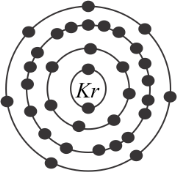
How many valence electrons does krypton have?
(A) 36
(B) 6
(C) 8
(D) 4
(E) 10
Answer
507.9k+ views
Hint:
As in this Question, we have to find the valence electrons. Firstly, Valence electron is an outer shell electron that is associated with an atom. It is located in the outermost shell of an atom; it is a negatively charged particle and it is transferred or shared with another atom. Let us take an example of Oxygen just to understand, as Oxygen has $6$ Valence electrons, two in the \[2s\] Subshell four in the \[2p\] subshell. So, the Configuration of Oxygen’s valence electrons is \[2{s^2}2{p^4}\]
Complete step by step answer:
As we know that Krypton is a chemical element & its symbol is Kr. Its atomic number is\[36\]. Talking about some main properties so it is a colorless, odorless, tasteless noble gas that occurs in the atmosphere and as in the question we have to calculate the valence electrons of Krypton since we discussed that Kr is a noble gas. It has a full valence shell or it also has an octet of \[8\]electrons. We can write the Electronic Configuration of Krypton as follows:
\[1{s^2}2{s^2}2{p^6}3{s^2}3{p^6}3{d^{10}}4{s^2}4{p^6}\]
Therefore, the valence shell of krypton is \[4\] and hence there are \[8\] electrons in this valence shell.
Moreover, we discuss the easiest method of finding valence electrons. So, for neutral atoms, the number of valence electrons is equal to the atoms main group number. And the group number of the Non-Transition metal can be used to find the valence electrons in that element. The main group member for an element can be found from its column on the periodic table. The one place of the group number is the number of valence electrons in an atom of these elements.
For Example: Carbon is in group \[4\] & it has \[4\] valence electrons.

Hence Option C is the correct one. As Krypton has \[8\] valence electrons.
Note:
Krypton is used in some flash lamps which are used for high-speed photography. For Energy Saving fluorescent lights, it is used as filling of gas.
As in this Question, we have to find the valence electrons. Firstly, Valence electron is an outer shell electron that is associated with an atom. It is located in the outermost shell of an atom; it is a negatively charged particle and it is transferred or shared with another atom. Let us take an example of Oxygen just to understand, as Oxygen has $6$ Valence electrons, two in the \[2s\] Subshell four in the \[2p\] subshell. So, the Configuration of Oxygen’s valence electrons is \[2{s^2}2{p^4}\]
Complete step by step answer:
As we know that Krypton is a chemical element & its symbol is Kr. Its atomic number is\[36\]. Talking about some main properties so it is a colorless, odorless, tasteless noble gas that occurs in the atmosphere and as in the question we have to calculate the valence electrons of Krypton since we discussed that Kr is a noble gas. It has a full valence shell or it also has an octet of \[8\]electrons. We can write the Electronic Configuration of Krypton as follows:
\[1{s^2}2{s^2}2{p^6}3{s^2}3{p^6}3{d^{10}}4{s^2}4{p^6}\]
Therefore, the valence shell of krypton is \[4\] and hence there are \[8\] electrons in this valence shell.
Moreover, we discuss the easiest method of finding valence electrons. So, for neutral atoms, the number of valence electrons is equal to the atoms main group number. And the group number of the Non-Transition metal can be used to find the valence electrons in that element. The main group member for an element can be found from its column on the periodic table. The one place of the group number is the number of valence electrons in an atom of these elements.
For Example: Carbon is in group \[4\] & it has \[4\] valence electrons.

Hence Option C is the correct one. As Krypton has \[8\] valence electrons.
Note:
Krypton is used in some flash lamps which are used for high-speed photography. For Energy Saving fluorescent lights, it is used as filling of gas.
Recently Updated Pages
Master Class 11 Chemistry: Engaging Questions & Answers for Success

Why are manures considered better than fertilizers class 11 biology CBSE

Find the coordinates of the midpoint of the line segment class 11 maths CBSE

Distinguish between static friction limiting friction class 11 physics CBSE

The Chairman of the constituent Assembly was A Jawaharlal class 11 social science CBSE

The first National Commission on Labour NCL submitted class 11 social science CBSE

Trending doubts
What is meant by exothermic and endothermic reactions class 11 chemistry CBSE

10 examples of friction in our daily life

One Metric ton is equal to kg A 10000 B 1000 C 100 class 11 physics CBSE

Difference Between Prokaryotic Cells and Eukaryotic Cells

What are Quantum numbers Explain the quantum number class 11 chemistry CBSE

1 Quintal is equal to a 110 kg b 10 kg c 100kg d 1000 class 11 physics CBSE




